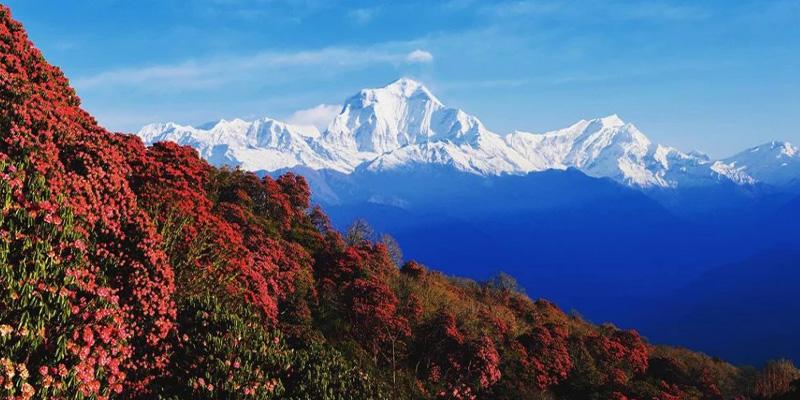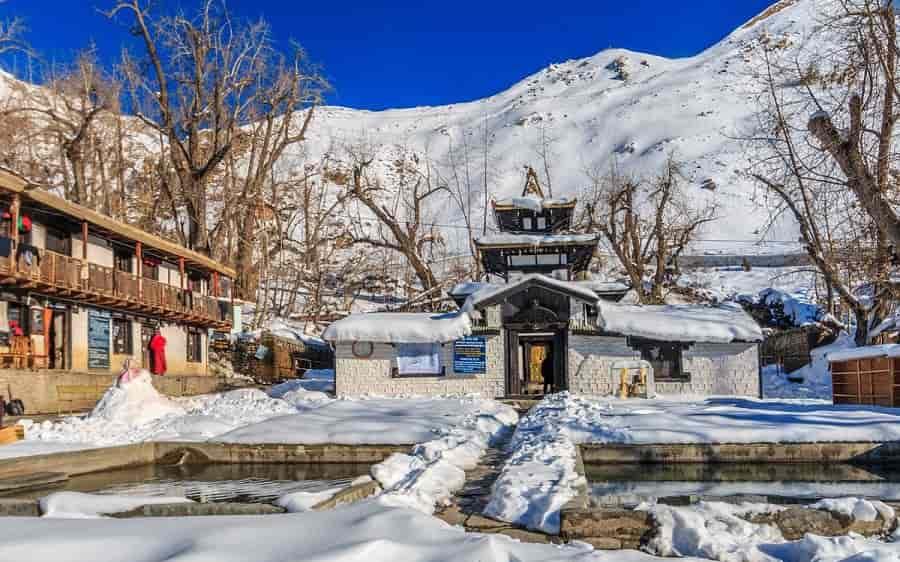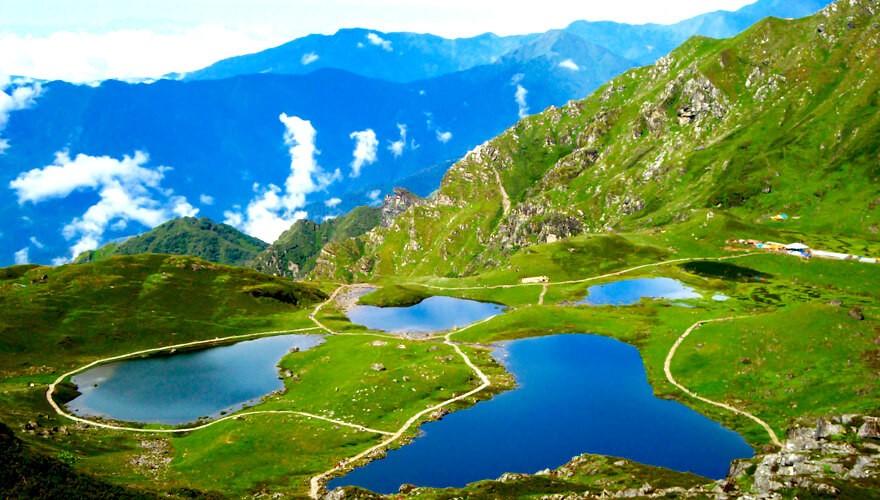Gosaikunda
- Author : Prasiddha Kc
- Date : 29th September, 2024
- Time : 1 Min Read
- Euphoria
- Blog Detail
Gosaikunda trek 5 days is a short and beautiful trek in the Langtang region of Nepal on the north of Kathmandu valley. The Gosainkunda trekking gives you a glimpse into the diverse landscape, culture, and nature as well as the Panoramic view of the Langtang Himalayan Range. Langtang National park has a lot of protected fauna, they are Rhesus monkey, snow leopard, wild boar, grey wolf, and more importantly this is also a Red Panda protected zone. Known as the holy lake is one of the easiest and short 5 days trek in Nepal. The trek is all about reaching Gosaikunda Lake which is elevated at 4380m. This is Nepal’s one of the sacred places for both Hindus and Buddhists people. These holy lakes get a big number of pilgrimage when there is a festival Janai Purnima. A shaman performs a different religious dance as well as worship on those days. Our Gosaikunda trek 5 days very short sweet which covers all aspects of the trek and gives a taste of Nepal.
Gosainkunda lakeHoly Gosainkunda lake 4380 Meter
Our Gosaikunda trek package begins driving from Kathmandu to Dhunche. With an outstanding view of the countryside, you will be able to enjoy driving even though the road is not good. Most of the road is not blacktopped. Dhunche headquarter of Rasuwa where you will spend a night. The walk starts from Dhunche by the next morning, the trail is accented with bamboo bushes and rhododendron tree. Cholangpati is an overnight place where you spent the next night before Gosainkunda. Viewpoint in Gosainkunda is another major attraction of this trek from where you can observe the Langtang Himalayan range. To back from here to Dunche is another 2 days trek. The Itinerary we offer is 4 days Gosaikunda trek, which means you will walk just 4 days on your trek. Some of you can even do it on 3 days but the Gosaikunda trek 3 days is quite tough.
Gosaikunda is a holy lake that lies at the heart of Langtang National Park. The source of the Trisuli river, Trisul Dhara has out from here. It is located at an altitude/height of 4,380 m (14,370 ft). Several other lakes such as Suryakunda, Bhairav Kunda and many others are below and above this lake. All lakes have their own religious significance.
According to Hindu myth Gosaikunda is the abode of the Hindu god Lord Shiva. Hindu scriptures Bhagavata Purana, Vishnu Purana refer to Samudra Manthan by god and devil from that poison produced and that poison started to destroy everything. Lord Shiva drunk that poison, afterward he got a neck burn then went to walk to the world seeking the cold place. When he arrived at Gosainkunda he hit the hill with his trident and drunk the cold water and lied down to the lake. This is the place where Big river Trisuli originates from here.
How to go gosaikunda from Kathmandu
The starting point of the gosaikunda is Dhunche Bazzar. From Dhunche it is 2 two-day uphill trek to Gosaikunda by crossing villages like Khanti, Deurali, Dhimsa, Sing Gompa, Cholagpati, and Lauri Bina. You can also start your trek from Thulo Syabru. From Thulo Syabru it takes 1 full day to reach the Gosaikunda. There is a Jeep road to Thulo Syabru as well. There are other trails from Nuwakot but it is longer and more steep and take more days so trekking from Dhunche and Thulo Syabru is highly recommended.
Gosaikunda Temple/Mandir
in the bank of the Holy Lake Gosaikunda lake there is a Small 2 story lord shiva temple. Devotees come to worship the Lord shiva after heaving the bath in the Holy Gosaikunda Lake. The Temple is just 1 minutes distance from the lake Gosainkunda.
Trihsul Dhara
The Trisul Dhara lies at 10-15 minutes’ distance from the Gosaikunda temple. Many believe that the source of the water of Gosaikunda lake and River Trisuli is Trishul Dhara. You can see 3 taps of waterfalls just above the trekking trails with the coins everywhere. This is the place where Lord Shiva hit Trishul.
Gosaikunda Mela/festival(गोसाइकुन्ड मेला)
Every year around June 3 in Janai Purnima there would be the biggest festivals in Gosaikunda(Gosaikunda Mela). Thousand of devotees from different areas go there to celebrate this festival. On this day many people take the bath on the Gosaikunda Lake and worship Lord Shiva. On the same day, Shaman also goes to Gosaikunda for the festivals. Around 2,000 or more devotees visit the Gosaikunda lake.
गोसाइकुन्ड मेला
गोसाइकुन्ड मेला जुन जनै पुर्णिमा मा लाग्दछ। जनै पुर्णिमा को लागि लाग्ने मेला मा अति भिड भाड हुने गर्दछ। येदि तपाई हरु पनि जाने सोच मा हुनुहुन्छ भने तपाईहरुले विविन्न कुराहरुमा ध्यान दिनुपर्छ।
यो बेला अरु बेला भन्दा अति बडी भक्तजनको भिड लाग्ने गर्दछ तसर्थ आफ्नो लागि चाहिने वस्तुहरु जसै सुत्ने बिछ्यौना (प्लास्टिकको म्याट), स्लीपिंग ब्याग अथवा सानो ओढ्ने राडी सकेसम्म आफै लिएर जानुहोला।
यो बेला होटेल मा सुत्ने ठाउँ पाउन सारै गारो हुन्छ तसर्थ अग्रिम बूकिंग गराउदा राम्रो हुन्छ। खन्ती, देउराली, धिम्सा, चन्दनबारी, चोलांगपाटि, लौरीबिना लगायत ठाउमा कोठा को समस्या हुन्छ। येदि होटेल पाउनु भएन भने खाना खुवाउन को लागि बनाएको अस्थाई टेन्ट मा सुत्नुपर्ने हुन्छ त्यो बेला आफुहरुले लागेको समान काम आउछ।
पहिलो दिन येदि १२ देखि १ बजे तपाइहरु धुन्चे मा पुग्नुभयो भने तेही दिन यात्रा सुरु गर्दा धिम्सा अथवा चन्दनबारी पुग्न सकिन्छ तर बाटो भने पुरै उकालो छ। खुड्किला हरु प्रसस्त छन्।
तपाइहरु सुस्तरी यात्रा गर्नुहोला अनि प्रसस्स्त पानि पिउनुहोला जसले लेक लाग्न बाट जोगाऊछ। धेरै झोलिलो खाने कुराहरु खानु पर्छ।
येदि टाउको दुखेमा, चक्कर लागेमा, साबिक भन्दा बढी थकाई लागेमा, बान्ता भएमा, बेचैनी भएमा, पखाला लागेमा, खाना खाना मन नलागेमा लेक लागेको हुन सक्छ जुन कुरा स्वयंसेबक अथवा प्रहरी लाई जानकारी गराउनु होला। चोलांगपाटि मा स्ववास्थ्य जाच गर्ने एउटा अस्थाई छेक पोस्ट पनि छ
येदि कसैलाई हिड्न सारै अप्ठेरो हुन्छ भने ठुलो स्याब्रु को बाटो भएर पनि जान सकिन्छ। येदि त्यो बेला ठुलो स्याब्रु सम्म गाडी चल्छ भने ठुलो स्याब्रु बसी अर्को दिन छोटो बाटो हुदै चोलाग पुगेर चन्दनबारी पुग्न सकिन्छ तर जानु अघि ठुलो स्याब्रु को होटेल संग सम्पर्ग गरेर जादा राम्रो हुन्छ
Gosaikunda Trek Itinerary
Days Itinerary Altitude Time
1 Arrival in Kathmandu 1350 Meters Your time
2 Dhunche 1,950 Meters 6-7 Hours
3 Sing Gompa 3330 Meters 6-7 hr
4 Gosainkunda 4380 Meters 6 – 7 hr
5 Cholang PatiSing Gompa 2450 Meters 6-7 hr
6 Dhunche 1950 Meters 6 hr
7 Kathmandu 1350 Meters 6 hr
8 Departure
Gosaikunda trek Itinerary in detail
This Gosaikunda trek itinerary is the Nepal Trek Hub Standard itinerary, this can be customized as per your time and your ability. We are here to customize your Gosainkunda trek itinerary please give us an email for modification of the itinerary
First day 01: Arrival in Kathmandu 1350 Meter
We welcome you at the Kathmandu international airport. Representatives from NTH will be at the airport to pick you up and take you to the Hotels. We will conduct the trek briefing for you and help you arrange your trek gears whether they are sufficient or not. If not sufficient then, we help you to hire and purchase in Kathmandu.
Second day 02: Drive to Dhunche for the trek 1950 Meters, 6-7 hours
For the Gosainkunda trek we need to take the Local bus or jeep. If you wish to take the Local bus then, the bus goes from the Machhapokhari bus park to Dhunche from early in the morning around 6: 00 Am. The road to Dhunche is not that good especially at the end near Dhunche due to the road expansion work most of the roads are dusty and bumpy. You can enjoy the beautiful scenery of the Nuwakot and Rasuwa while driving to the Dhunche.
Third day 03: Trek to Sing Gompa 3330 Meters, 6-7 hours.
From Dhunche, the trek goes regularly to the Gosainkunda. The trail is full of the forest where you can see the juniper, oak, and rhododendron trees. The trails go slowly high till the Cholangpati then to Sing Gompa. Sing Gompa is one of the very popular monasteries of the Langtang regions. Overnight at the Sing Gompa.
Fourth day 04: Gosaikunda trek 4380 Meters, 6-7 hours.
This is the most exciting day of the trek, you can see the numerous snow-capped peaks while trekking to the Gosaikunda. There is a famous place which is known as Chandanwari from where you can see the splendid mountain ranges. The trails now lose the tree line and get some Himalayan bushes alongside the trek trails. This is the place where people usually get AMS. After crossing the Lauribina there is a Ganesh temple which is one of the best places to observe the mountain scenery. Now, the trail moves sideways to the Gosaikunda lake. Before Gosaikunda you can see the massive Bhairav Kunda. Kunda is the translation of a lake in English. Stay overnight at the Gosainkunda lake
Fifth day 05: Trek down to Cholang pati 2450 Meters, 6-7 hours
Today is another exciting day, we explore the Gosaikunda lake and laurebina la pass to have the best view. Having breakfast then we will go down to Cholang Pati and stay overnight at the hotel.
Sixth day 06: Return back to Dhunche 1950 Meters, 6 hours.
The final day of the trek will be complete, when we will reach down to Dhunche
Seventh Day 07: Drive back to Kathmandu.
Return back to Kathmandu.
Eighth Day 08: Departure
Departure.
Gosaikunda pass trek anti clockwise
Some of the trekkers these days also do the Gosainkunda trek Anti-clockwise. They find it is more quiet, beautiful, and adventurous. It is true that around Gosainkunda trek anti-clockwise is more adventurous and perfect for the trekkers who seek a quiet zone for their trek. The trek starts from Kathmandu Sundarijal and ends in the Dhunche of Rasuwa. You will cross Lauribina la pass 4681 Meters anti-clockwise which means opposite Gosainkunda trek. This is more interesting and unique rather than the regular Gosainkunda trek. trekkers see other trekkers only at overnight time and lunchtime. You will be almost alone to do this trek with your team
Leave A Comment:
Author
Related Blogs
1 min read
by Anuja Pneru
Ghorepani Ponhill Trek
Ghorepani Poon Hill Trek is a perfect short beautiful journey in the Annapurna region. It is probably the most satisfying and finest destination in Ne...
1 min read
by Anuja Pneru
Mukinath
The temple of Muktinath is in the trans-Himalayan locale of Nepal at the foot of the snow-covered ranges at an altitude of 3,800 m. The site is sacred...
1 min read
by Prasiddha Kc
Panch pokhari
"Join a less-visited trekking route located nearby Kathmandu and get to experience distinct trekking to one of the pilgrimage sites in Nepal on our Pa...



